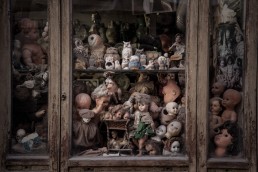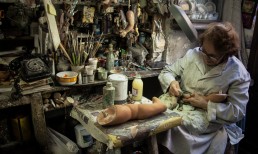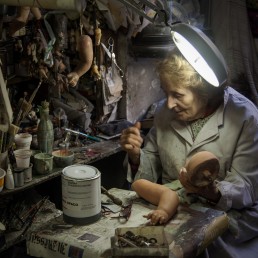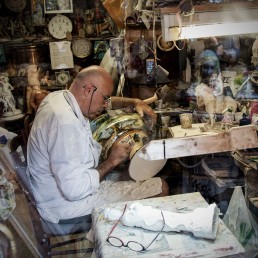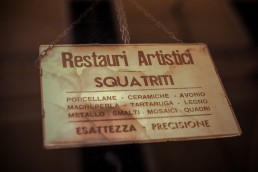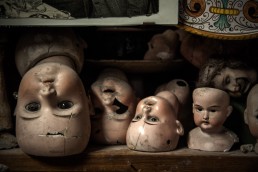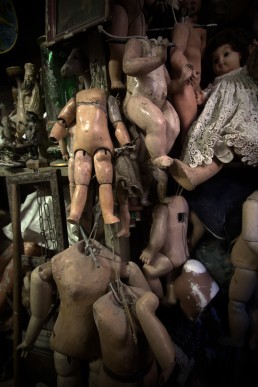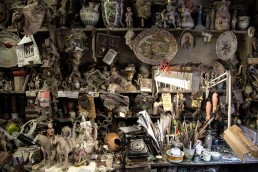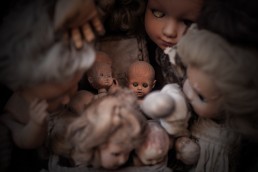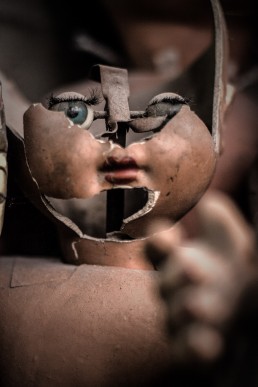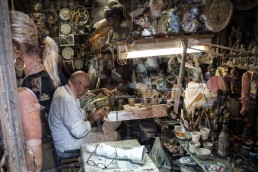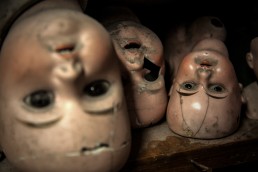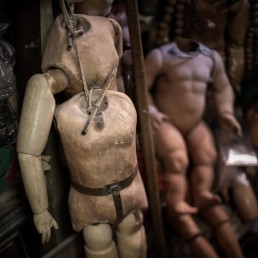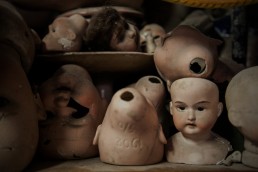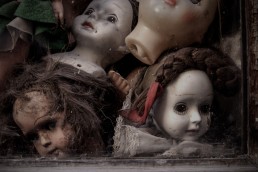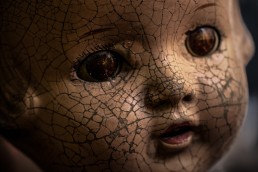For more than 60 years, a devoted Italian family has been nursing broken dolls back to health from their creepy shop in Rome. As their neighbourhood gentrifies, the proprietor wonders how much longer the tradition will survive.
ROME BOASTS MANY attractions with disturbing histories, from the blood-soaked Colosseum to the skeleton-filled Capuchin Crypt. And on a cobbled alleyway in one of the city’s most fashionable neighbourhoods, a small shop window offers another seemingly gruesome glimpse into the Italian capital’s past.
Behind the dust-dulled glass, unblinking eyes stare from decapitated heads. Severed arms, legs, hands and feet hang in bunches from rusty nails. This little shop of horrors, known locally as l’Ospedale delle Bambole, or “the Hospital of the Dolls”, was established by the Squatriti family more than six decades ago.
Body parts have been accumulating there ever since.
CRACKED PAINT PEELS from the weathered window frame of the “hospital”. Inside, Federico Squatriti, 52, and his 82-year-old mother, Gelsomina, continue a family tradition of nursing broken antique dolls back to health, and paint-spattered walls, cobwebbed shelves and busy workbenches are cluttered with fractured figurines, wounded toy soldiers and mangled puppets.
“It has always been owned by our family, so we haven’t changed anything,” says Federico of his cramped and fascinating atelier, which has become a macabre and offbeat tourist attraction in recent years. The ramshackle workshop — a halfway house for refugees from the most sinister of fairy tales — sits just a stroll from the sparkly Gucci, Versace and Dolce & Gabbana boutiques on Rome’s swanky Via dei Condotti.
“It looks like an old-fashioned shop because it is an old-fashioned shop,” Squatriti says. “It’s looked the same since the beginning.”
He takes a fading black-and-white photograph, taken in the 1970s, from a shelf. “This picture is more than 30 years old,” he says. “This is my father, when he was still alive, and my mother. Look how many things there were, all scattered everywhere. This is how we work every day, with so many beautiful objects all around us.”
HAILING FROM NAPLES, Federico’s grandfather, Vincenzo Squatriti, was an actor with the respected La Scarpetta theatre company in the 1950s. Under the stage name Enzo Petito, he later worked alongside silver-screen legends Gina Lollobrigida and Marcello Mastroianni, and even had a minor role as a gun-store owner in Sergio Leone’s classic 1966 spaghetti western The Good, the Bad and the Ugly.
Before that, in the wretched years following World War II, Vincenzo’s wife, Concetta, decided acting to be too unstable a profession for her family’s future. “My grandmother urged her children to learn a craft because acting didn’t make much money after the war,” Squatriti says.
Though struggling with rising materials costs and crippling rent in one of Rome’s once working-class but now gentrified and touristy neighbourhoods, Federico Squatriti is reluctant to turn away new patients
In 1953, Concetta opened Restauri Artistici Squatriti (Artistic Restorations Squatriti) in Rome with her two sons: Federico’s father Mario and his uncle Renato. “Since then all my family has worked here,” Squatriti says of their tiny workplace, which covers about 150 square feet. The still air is acrid with enamel, glue and solvents. “My grandmother, my father, my uncle, my aunt, my cousins, my mother and myself.”
Squatriti cannot remember when he joined the family business. “We lived in an apartment upstairs, and when I was young and returned from school, I would drop by to say ‘hi’ to my dad, my grandma and my uncle,” he remembers.
“I don’t recall exactly when one of them first said, ‘Federico, please help with this.’ I started out by returning restored items to customers, then I would be sent off to buy materials, and little by little I ended up working here too.”
THE SQUATRITI BUSINESS initially survived by restoring ceramic, tortoiseshell, metal, ivory, wooden and mosaic heirlooms damaged during the war for Rome’s aristocracy — the only people who could afford such a luxury at the time. Dolls came later.
Historically, the earliest dolls date back to ancient Egypt, Greece and, indeed, Rome (Roman rag dolls have been found dating back to about 300BC). Their heyday arrived in the 19th century, and the bodies of European dolls at that time were roughly hewn from leather, wood or papier-mâché, and hidden under fanciful costumes of lace, silk and taffeta. Their heads, however, were increasingly made from delicate porcelain and starting to look creepily real, with detailed eyelashes, beauty spots, even wrinkles.
“The best solution is to work well and work long enough. It’s something you do for your customers, not just for money”
Federico Squatriti
They were no longer children’s playthings but collectors’ items for the moneyed elite. Squatriti lifts one such doll’s head from a shelf, cups it in a hand and brushes away generations of dust.
“It’s more than 100 years old,” he says of the antique, which is inscribed with the year 1902. Many items in the shop are unclaimed toys of children long grown old or passed away, he adds. Some have been there for decades and will likely never be reclaimed. “We started to restore dolls’ heads because they required the same methods as other porcelain items,” Squatriti says.
TODAY, UP TO 1,000 period pieces — plates, vases, statuettes and more, as well as many dolls — are looked after every year at the Restauri Artistici Squatriti workshop, and Federico Squatriti, like any dedicated family doctor, feels a profound responsibility for his clients’ wellbeing. Though struggling with rising materials costs and crippling rent in one of Rome’s once working-class but now gentrified and touristy neighbourhoods, he is reluctant to turn away new patients.
“If I wanted to work only seven or eight hours a day, I would need to charge more, but then fewer people could afford to restore their dolls and their antiques,” Squatriti says. Dozens of cold, creepily human-looking eyes appear to watch as he speaks.
“The best solution is to work well and work long enough. It’s something you do for your customers, not just for money. It’s satisfying for me, at the end of the day, to say to myself, ‘I’ve worked for 11 hours, the result came out beautifully, and I managed to do it for a reasonable price.’
“The people are happy and I am happy. It’s all beautiful!” ◉
This ran in Post Magazine (PDF) in 2015. The pictures were published that year in Mail Online and Panorama magazine in Italy, and later in online photography magazine Life Force. The Guardian chose one picture for its globally sourced 'Photo Highlights of the Day' in April 2015.
SHARE


